Would you like to start using a breast pump but you don’t know how to handle the breast milk? Or maybe you’ve been already pumping but you’re not sure if you store the milk properly?
It’s important to follow a few basic safety rules which will help to protect your breast milk from contamination and minimize the risk of food poisoning!
Keep on reading to learn most essential information on how to store breast milk.
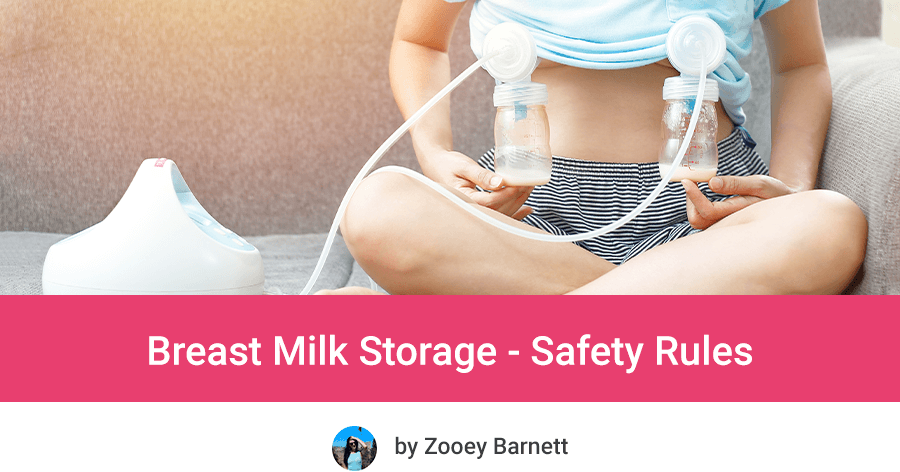
In this article I gathered essential information on how to handle expressed breast milk. These are the general guidelines, based on CDC recommendations.
However, you should keep in mind that various factors may affect how long the breast milk can be stored safely. Among most important factors are: room temperature when the milk was expressed, milk volume, temperature in the refrigerator or freezer and temperature changes, cleanliness of the environment (of the milk container, as well as the fridge/freezer).
This article is not a substitute for medical care or medical consultation.
How To Store Pumped Milk
It’s important that you use only the storage bags or containers that are intended for storing breast milk – which means they are specially designed for storing human milk.
You can choose between disposable milk storage bags or food-grade containers which are made of plastic or glass and have tight fitting lids.
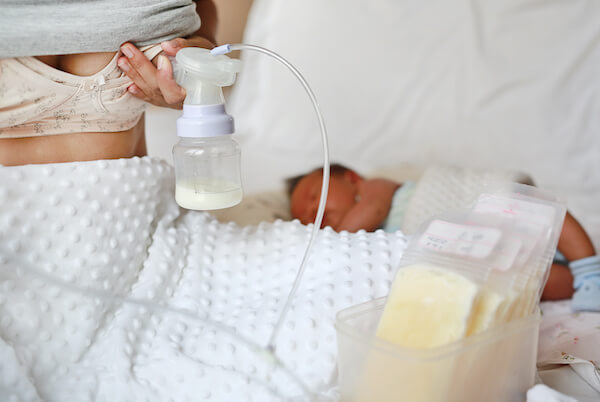
NEVER store your expressed breast milk in plastic bags, disposable bottles or other containers that are NOT intended for storing human milk.
Important rule: Don’t use containers with recycle symbol number 7 – because they contain BPA which is harmful for babies. Moreover, you should never store breast milk in
| Hesitating which type of a breast pump to choose? Or maybe you’re not sure how and when start pumping? Read our breast pumping essential guide and learn how to handle it safely. You may also want to check out our review of Willow – one of the best wearable breast pumps in 2023! |
How Long Can You Store Breast Milk? – CDC Rules
You can store freshly pumped milk1:
- At room temperature (up to 77°F): up to 4 hours
- In a refrigerator (up to 40°F): up to 4 days
- In a freezer (less than 0°F): Best up to 6 months (other sources say 3-6 months)
If you’re traveling or expressing milk at work, you can store the milk in an insulated cooler bag with frozen ice packs. Keep in mind that you can keep it that way only up to 24 hours!
Keep in mind that these rules are only for healthy full-term babies. There may be different guidelines for premature or sick babies. You should consult how long can you store the breast milk with your health care provider or pediatrician.
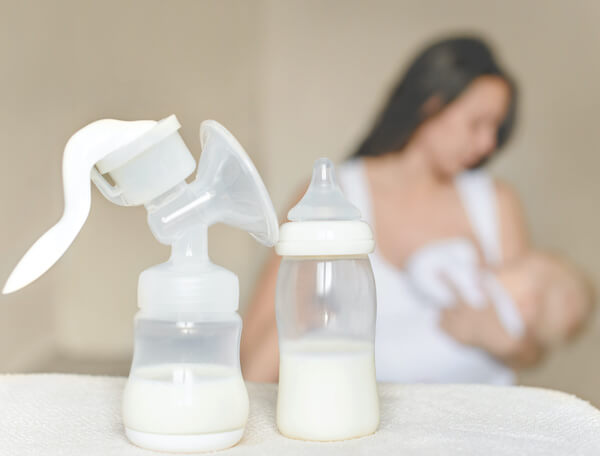
Other Safety Rules For Storing Breast Milk
- Always label your breast milk containers with the date and time the milk was expressed.
- If you don’t plan to use the freshly pumped milk within 4 days, put it in the freezer right away – to protect its quality.
- When you store breast milk in the freezer, never put it on door shelves or on the front of the shelves because it may pose a risk of thawing and re-freezing. Milk containers should be placed on the bottom (or in the back) of the freezer.
- When storing milk in the fridge, always place it near the back wall. Never on the fridge door or in the front part, because it would be exposed to frequent temperature changes from opening and closing the door, which will have an impact on milk quality and edibility.
- If you want to freeze your pumped milk, you should leave about an inch of space at the top of the milk container, because the milk will expand during freezing.
| PRO TIP: Freeze your expressed milk in small amounts – one portion for one feeding to avoid wasting the milk that your baby won’t eat. Thawed milk cannot be re-frozen or added to another portion. |
What You Should Never Do With Pumped Breast Milk
- Do not mix your pumped breast milk with infant formula.
- Do not add warm breast milk to frozen breast milk because it will cause the frozen milk to partially thaw.
- NEVER refreeze thawed milk.
- Do not serve your baby milk that has higher temperature than 98.6°F.
- Do not boil breast milk.
- For freezing your breast milk, avoid plastic containers with BPA or containers after food products (I mean re-using a bottle from orange juice etc.).
- If you notice air bubbles in your frozen breast milk it can indicate it’s gone bad (find out more about foamy breast milk here).
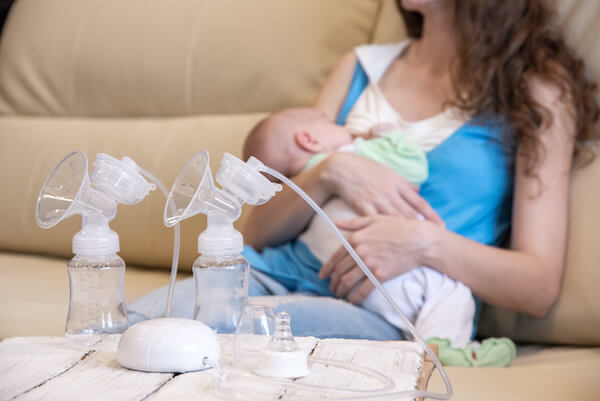
How To Thaw Breast Milk From The Freezer
Always follow the rule ‘first in, first out’ – which means you should always thaw the oldest milk first. There are a few safety rules that you should follow to thaw and prepare the milk in a safe way2.
Basically you have 3 ways to thaw your frozen breast milk:
- You can put it in the refrigerator to defrost overnight – the milk will defrost slowly within 12-24 hours
- You can place it in a bowl of warm/lukewarm water – it’s a better option if you don’t have a lot of time. But keep in mind that you should never put the milk in boiled water!
- You can hold it under lukewarm running tap water
It may be temping to defrost the milk in a microwave because it’s quicker but you should never do that! First of all, it may create hot spots which can burn baby’s mouth. Besides, microwave can destroy nutrients in the expressed breast milk. Similarly, never defrost the breast milk in an oven and don’t boil it.
If you chose to defrost the milk overnight in a refrigerator, and the milk is completely thawed, you should use it within 24 hours, but keep it in the refrigerator the whole time and only warm it before serving.
If you brought the milk to room temperature or you warmed it after storing in refrigerator, you should use it within 2 hours.
Once the breast milk has been thawed, you should never refreeze it.
| PRO TIP: After thawing the milk, it may be surprising that there is a yellow layer floating on the surface. Don’t worry, it’s just a fat that separated from the milk. It should not be removed, but gently mixed with the rest of the milk. Simply swirl the milk. |
Feeding The Baby With Expressed Breast Milk
When you serve pumped milk to your baby, its temperature cannot be higher than 98.6°F, at the same time it should not be colder than room temperature (although CDC says it can be served cold). Freshly expressed milk can be serve without heating.

| PRO TIP: Breast milk ingredients change as the baby grows so there is no point in doing huge stocks of your milk in the freezer. Even thought the breast milk can be frozen up to 6 months, it’s better to keep the amount of milk that you can use within few weeks. Milk frozen for 6 months maintains nutritional values, so it won’t be harmful for the baby, but will not support him accordingly to current needs. |
How to warm the breast milk after storage in refrigerator or once its thawed:
- Put the container with your expressed breast milk in a pot/bowl/container of warm water for a few minutes or hold the milk container under warm tap water two warm the milk. Never put it in a hot/boiling water.
- The container should be sealed during the warming.
- Don’t use stove or microwave for warming the milk.
- Before feeding the baby, test the milk temperature – put a few drops on your wrist. If it feels warm you can serve it to your baby, if it’s hot – wait until it cools down a bit and test it again.
| PRO TIP: If your baby didn’t finish the bottle, you can use the rest of the milk within 2 hours, but not longer. After 2 hours the milk should not be served to the baby and you should discard the leftovers. If you want to avoid waisting milk, the best way is to freeze/store small amounts of freshly pumped milk, accordingly to the amount of milk that baby eats during one feeding session. |
There is also one more general rule that I should mention – whenever you’re pumping or handling your breast milk, you should wash your hands first. CDC recommends using soap and water or, if these are not available, alcohol-based sanitizer (at least 60% of alcohol).
If you’d like to read more about how to store breast milk after pumping or learn more on how to freeze breast milk, you should visit CDC website. Below you can see a useful infographic with CDC recommendation on how long you can keep the expressed breast milk at room temperature, in refrigerator and in freezer3.
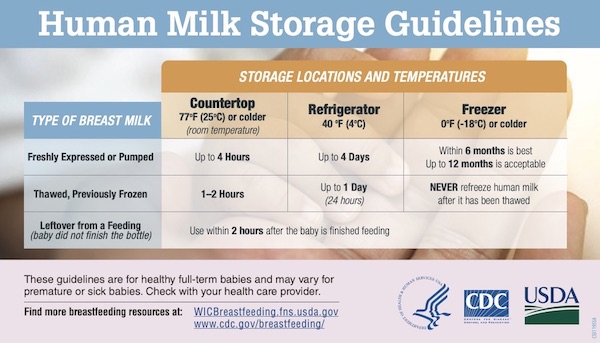
The purpose of this article is informative. It’s not a substitute for medical consultation or medical care. Remember: safety first! Before you start breast pumping and/or have any doubts about your or your baby health condition, consult with a qualified lactation advisor and/or your GP!
Moreover, these general guidelines may differ from your hospital rules in certain situation. You should consult with your baby’s pediatrician and/or hospital how to handle the breast milk properly in your specific circumstances.
References:
https://www.cdc.gov/
https://www.womenshealth.gov/
https://www.healthychildren.org/

